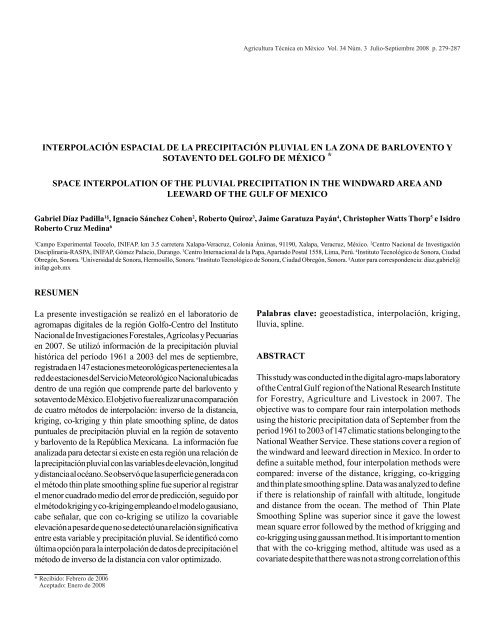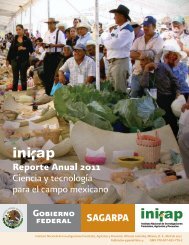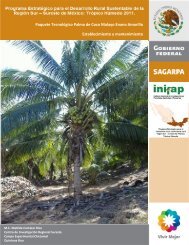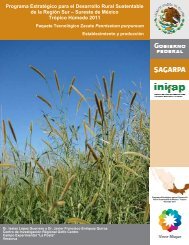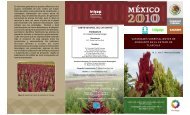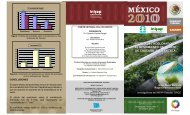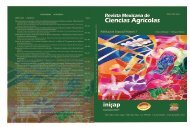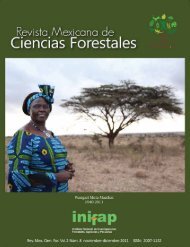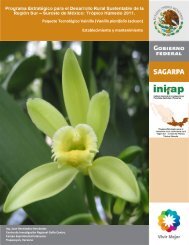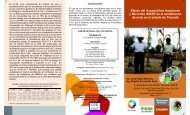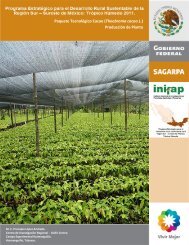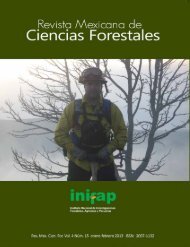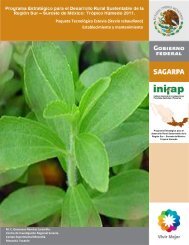Vol. 34 Núm. 3 - Instituto Nacional de Investigaciones Forestales ...
Vol. 34 Núm. 3 - Instituto Nacional de Investigaciones Forestales ...
Vol. 34 Núm. 3 - Instituto Nacional de Investigaciones Forestales ...
Create successful ePaper yourself
Turn your PDF publications into a flip-book with our unique Google optimized e-Paper software.
Agricultura Técnica en México <strong>Vol</strong>. <strong>34</strong> Núm. 3 Julio-Septiembre 2008 p. 279-287INTERPOLACIÓN ESPACIAL DE LA PRECIPITACIÓN PLUVIAL EN LA ZONA DE BARLOVENTO YSOTAVENTO DEL GOLFO DE MÉXICO *SPACE INTERPOLATION OF THE PLUVIAL PRECIPITATION IN THE WINDWARD AREA ANDLEEWARD OF THE GULF OF MEXICOGabriel Díaz Padilla 1§ , Ignacio Sánchez Cohen 2 , Roberto Quiroz 3 , Jaime Garatuza Payán 4 , Christopher Watts Thorp 5 e IsidroRoberto Cruz Medina 61Campo Experimental Teocelo, INIFAP. km 3.5 carretera Xalapa-Veracruz, Colonia Ánimas, 91190, Xalapa, Veracruz, México. 2 Centro <strong>Nacional</strong> <strong>de</strong> InvestigaciónDisciplinaria-RASPA, INIFAP, Gómez Palacio, Durango. 3 Centro Internacional <strong>de</strong> la Papa, Apartado Postal 1558, Lima, Perú. 4 <strong>Instituto</strong> Tecnológico <strong>de</strong> Sonora, CiudadObregón, Sonora. 5 Universidad <strong>de</strong> Sonora, Hermosillo, Sonora. 6 <strong>Instituto</strong> Tecnológico <strong>de</strong> Sonora, Ciudad Obregón, Sonora. § Autor para correspon<strong>de</strong>ncia: diaz.gabriel@inifap.gob.mxRESUMENLa presente investigación se realizó en el laboratorio <strong>de</strong>agromapas digitales <strong>de</strong> la región Golfo-Centro <strong>de</strong>l <strong>Instituto</strong><strong>Nacional</strong> <strong>de</strong> <strong>Investigaciones</strong> <strong>Forestales</strong>, Agrícolas y Pecuariasen 2007. Se utilizó información <strong>de</strong> la precipitación pluvialhistórica <strong>de</strong>l período 1961 a 2003 <strong>de</strong>l mes <strong>de</strong> septiembre,registrada en 147 estaciones meteorológicas pertenecientes a lared <strong>de</strong> estaciones <strong>de</strong>l Servicio Meteorológico <strong>Nacional</strong> ubicadas<strong>de</strong>ntro <strong>de</strong> una región que compren<strong>de</strong> parte <strong>de</strong>l barlovento ysotavento <strong>de</strong> México. El objetivo fue realizar una comparación<strong>de</strong> cuatro métodos <strong>de</strong> interpolación: inverso <strong>de</strong> la distancia,kriging, co-kriging y thin plate smoothing spline, <strong>de</strong> datospuntuales <strong>de</strong> precipitación pluvial en la región <strong>de</strong> sotaventoy barlovento <strong>de</strong> la República Mexicana. La información fueanalizada para <strong>de</strong>tectar si existe en esta región una relación <strong>de</strong>la precipitación pluvial con las variables <strong>de</strong> elevación, longitudy distancia al océano. Se observó que la superficie generada conel método thin plate smoothing spline fue superior al registrarel menor cuadrado medio <strong>de</strong>l error <strong>de</strong> predicción, seguido porel método kriging y co-kriging empleando el mo<strong>de</strong>lo gausiano,cabe señalar, que con co-kriging se utilizo la covariableelevación a pesar <strong>de</strong> que no se <strong>de</strong>tectó una relación significativaentre esta variable y precipitación pluvial. Se i<strong>de</strong>ntificó comoúltima opción para la interpolación <strong>de</strong> datos <strong>de</strong> precipitación elmétodo <strong>de</strong> inverso <strong>de</strong> la distancia con valor optimizado.Palabras clave: geoestadística, interpolación, kriging,lluvia, spline.ABSTRACTThis study was conducted in the digital agro-maps laboratoryof the Central Gulf region of the National Research Institutefor Forestry, Agriculture and Livestock in 2007. Theobjective was to compare four rain interpolation methodsusing the historic precipitation data of September from theperiod 1961 to 2003 of 147 climatic stations belonging to theNational Weather Service. These stations cover a region ofthe windward and leeward direction in Mexico. In or<strong>de</strong>r to<strong>de</strong>fine a suitable method, four interpolation methods werecompared: inverse of the distance, krigging, co-kriggingand thin plate smoothing spline. Data was analyzed to <strong>de</strong>fineif there is relationship of rainfall with altitu<strong>de</strong>, longitu<strong>de</strong>and distance from the ocean. The method of Thin PlateSmoothing Spline was superior since it gave the lowestmean square error followed by the method of krigging andco-krigging using gaussan method. It is important to mentionthat with the co-krigging method, altitu<strong>de</strong> was used as acovariate <strong>de</strong>spite that there was not a strong correlation of this* Recibido: Febrero <strong>de</strong> 2006Aceptado: Enero <strong>de</strong> 2008


